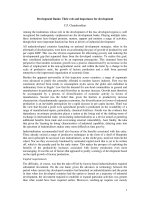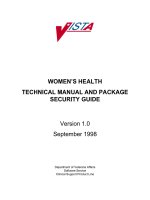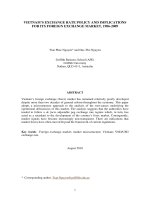Women’s Health Physiotherapy Information and advice for women ppt
Bạn đang xem bản rút gọn của tài liệu. Xem và tải ngay bản đầy đủ của tài liệu tại đây (394.24 KB, 8 trang )
Women’s Health
Physiotherapy
Information and advice
for women
Women’s Health Physiotherapy
This booklet is designed to help you better understand some of your
gynaecological problems and symptoms. It contains advice and
exercises which will form the basis of your physiotherapy treatment.
As part of your assessment your physiotherapist may complete a vaginal
examination. This will be fully discussed with you at your appointment.
If you would like any further information after reading it, please contact:
Women’s Health Physiotherapy
Ground Floor, Lift Bank C
Chelsea and Westminster Hospital
369 Fulham Road
London
SW10 9NH
T: 020 3315 8404
Notes
2
3
How common is urinary
incontinence?
Estimates vary—about 10–30% of all
women have some incontinence but
only a quarter of these women seek help.
Types of incontinence
• Stress leakage with effort/exertion
(lifting, running, jumping) or with
sneezing/coughing
• Urge leakage with or immediately
preceded by urgency (often you can’t
make it to the loo in time)
• Mixed leakage associated with
urgency and with exertion/effort/
sneezing/coughing
Other urinary problems
• Frequency—complaint of urinating
too often in the daytime (more than
8 times/24 hours)
• Urgency—sudden, compelling desire
to urinate which is hard to put off
• Nocturia—getting up at night one or
more times to urinate
• Combination of all three problems
Facts and figures
Normal bladder size/volume
400–600mls
Recommended fluid intake
1.5–2 litres/24 hours
3–4 pints/24 hours
Average n° of times to pass urine
4–8 times/24 hours
Average n° of times to open bowels
From 3 times/24 hours to 3 times/week
Food and drink that may irritate the
bladder and increase your urgency
to urinate
• Coffee/tea(caffeine)
• Carbonated(zzy)drinks,especially
those with caffeine
• Alcohol
• Citrusjuice(egorange/grapefruit)
• Lowuidintake(concentratedurine)
• Somespicyfoods
• Nicotine
Drinks that do not irritate the bladder
• Water
• Squashesinwater
• Fruitteas
• Herbaltea
• Decaffeinatedcoffee/tea
• Non-citrusfruitjuices(egapple)
Advice for patients with
urgency and/or urge
incontinence
1. Try to reduce alcohol, fizzy drinks
(especiallyCoca-Cola)andcaffeine
intake (or drink decaffeinated tea/
coffee).
2.Aimtodrinkthreepintsor1–2litres
ofuidseachday,waterisbest.
3. Try to avoid going to pass urine ‘just
in case’—only go if you need to.
4.Whenyougettheurgetourinate,try
to ‘hang on’—here are some tips:
a) Keep calm—don’t panic
b)Standstillorsitdown
c)Crossyourlegs
3
d)Stronglysqueezeyourpelvicoor
muscles
e)Waituntiltheurgencypasses
(10–20 seconds), then carry on
with your activity
5. Try to delay going to the toilet,
gradually extending the time between
voids, up to three hours.
6. If you get up in the night to empty your
bladder, don’t drink after 8:30pm.
7. You will have good days and bad days
to start with but don’t give up.
Pelvic organ prolapse
If you have been diagnosed with a
prolapse please read the following
information.
Aprolapse occurswhenone or a
combination of the pelvic organs—uterus,
bladder or bowel—lose their normal
support and move out of position.
Normal
Uterine prolapse Rectocele
(uterus) (bowel)
Cystocele Enterocele
(bladder) (small bowel)
Causes of prolapse include:
• Pregnancyandchildbirth
• Ageingandmenopause
• Weakpelvicoormuscles
• Constipation
• Heavylifting
• Obesity
• Largebroids
Symptoms include:
• Sensationofa‘lump’or‘something
coming down’
•Pressure,heavinessorpaininthe
vagina
• Backache
• Difcultyemptyingthebladder/bowel
• Repeatedurineinfections
• Discomfortduringsexualintercourse
Managing a prolapse:
• Practicepelvicoormuscleexercises
regularly
•Brace(squeeze)yourpelvicfloor
prior to coughing, sneezing, straining,
running, jumping or lifting
• Avoidheavypushing/pulling/lifting/
heavy housework
4
Uterus
Peritoneum
Bladder
Smallbowel
Largebowel
Urethra
Vagina
•Avoid high-impact exercise (ie
jogging, aerobics etc) or exercise
that increases the pressure in the
abdomen(sit-upsorrowing)
• Trytoavoidlongperiodsofstanding
without a break
• Avoidstrainingtoemptyyourbowels,
eat a balanced diet and drink enough
uidstopreventconstipation
• Avoidsmokingandchestinfections—if
you get a chest infection, seek prompt
treatment to minimise coughing
• Loseweightifyouneedtobecause
this will reduce the pressure on your
pelvicoormuscles
•Sexualintercoursewillnotmake
your prolapse worse but may be
uncomfortable—try using a vaginal
lubricant or varying positions
Opening your bowels
The following position and techniques
to open your bowels should stop you
from straining:
Position
• Legsapart
• Leanforward
• Forearmsrestingonknees
• Backstraight
• Feetuponstool(kneesalittlehigher
than hips)
Action
•Relaxyourjaw(mouthopen,teeth
apart)
• Bulgeyourlowertummyforwardand
make your waist wide—a pear shape
• Feelyourbackpassagerelax
• Maintainthispositionbreathinggently
as you open your bowels
Tips to help with constipation
If you suffer from constipation or
strain to open your bowels you may be
weakening your pelvic floor muscles
further.
• Besuretodrinkaminimumof1.5–2
litresofuidaday—trytomakewater
a large percentage of this
•Eatplentyoffibre(egfreshfruit
and vegetables, cereals, wholemeal
breads and pasta)
•Eatbreakfastaftergettingupand
don’t miss meals during the day
• Don’tdelaygoingtoopenyourbowels
after you have felt the urge—you are
less likely to strain if your body is
ready
• Giveyourselftimetogo—do not rush
•Keepactive—exerciseencourages
regular bowel habits
•If constipated tryusing natural
products (eg prune juice, linseed plus,
dried fruit)
5
Pelvic floor exercises
What is the pelvic floor?
The pelvic floor consists of layers of
muscle and ligaments that stretch like
a hammock from the pubic bone in
front to the end of the backbone and
from side to side (see diagram). Firm,
supportivepelvicoormuscleshelpto
hold the bladder, womb and bowel in
place, and to close the bladder outlet
and back passage.
How does the pelvic floor work?
Themusclesofthepelvicoorarekept
rmandslightlytensetostopleakage
of urine from the bladder and wind or
faecesfromthebowel.Whenyoupass
water or have a bowel motion the pelvic
oormusclesrelax.
Afterwards, they tighten again to
restore control. The muscles should
also squeeze when you laugh, cough or
sneeze so as to help you avoid leaking.
In addition, they have an important
sexual function for both yourself and
your partner during sexual intercourse.
What weakens the
pelvic floor muscles?
• Pregnancy/childbirth
• Repeatedstrainingwhenopeningyour
bowels (constipation)
• Overweight
• Chroniccough
• Menopause(hormonalchanges)
• Highimpactexercise/heavylifting
• Medicalproblems
Weakmusclesgiveyoulesscontrol
and you may leak urine, especially with
exercise or when you laugh, cough, lift
or sneeze.
How can I strengthen my
pelvic floor muscles?
Exercising the pelvic floor muscles
(at any age) can strengthen them so
that they once again give support. This
will improve your bladder control and
improveorstopleakageofurine.Like
any other muscles in the body, the more
you use and exercise them, the stronger
thepelvicoormuscleswillbe.
How to perform pelvic
floor exercises
Sitcomfortablywithyourkneesslightly
apart.
Nowimagineyouaretryingtostop
yourself passing wind from the bowel
or trying to stop the stream of urine. You
do the exercise by squeezing and lifting
the muscles, closing and drawing up the
front & back passages.
6
Bladder
outlet
Urethra
Vagina
Bladder
Uterus (womb)
Spine
Rectum
Anus
Pelvicoor
muscles
Exercising your pelvic floor muscles
should not show at all ‘on the outside’.
You should not pull in your tummy exces-
sively, squeeze your legs together, tighten
yourbuttocks-orholdyourbreath.
There are two types of exercises:
• Slow (squeeze and lift)—Holdthe
squeeze for as long as you can, up to
10 seconds, then release and rest for
four seconds (repeat 5–10 times)
• Fast—follow this with up to 10 quick
strong contractions which will help
your muscles react quickly when you
laugh, cough, sneeze, exercise or lift
Try to do these slow and fast squeezes
at least 3–5 times a day.
Where do I do these
exercises?
Youcandoyourpelvicoorexercises
anywhere—lying/sitting/standing—but it
is not advisable to do them on the toilet
while urinating.
It takes time for muscles to get stronger.
You are unlikely to notice any improve-
ment straight away so stick at it.
You will need to exercise regularly for
several months before the muscles gain
their full strength.
Your physiotherapist will be able to
check whether you are doing these
exercises correctly and progress them
as appropriate for you.
7
Notes
369FulhamRoad
London
SW109NH
Main Switchboard
+44 (0) 20 8746 8000
Website
www.chelwest.nhs.uk
February 2011
• •Español•
Lietuviškai•Polski•Português
Русский•Soomaali•
020 3315 6727









